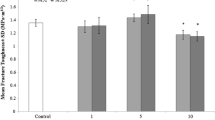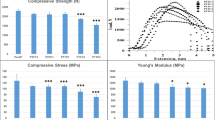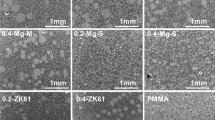Abstract
Although current commercial acrylic bone cements have been used successfully in total joint replacement surgery for over five decades, some further improvement are being investigated to cope with cement failure, one approach is surface modification of BaSO4 particles to improve its interfacial adhesion with the polymeric matrix in acrylic bone cements formulations. In this article, BaSO4 particles were modified by different surface treatments. The first of them involved the use of 3-(trimethoxysilyl)propyl methacrylate as a coupling agent; in the second, the radiopaque particles were exposed to oxygen plasma at power levels of 15 and 70 W, followed by MPS coupling agent and the last one consisted in exposing the radiopaque particles to methyl methacrylate (MMA) plasma. Mechanical properties of the bone cements prepared with modified BaSO4 particles were improved due to its higher dispersion degree in polymeric matrix.






Similar content being viewed by others
References
Kühn KD (2012) Bone cements, up-to-date comparison of physical and chemical properties of commercial materials. Springer, Berlin
Haas SS, Brauer GM, Dickson GA (1975) Characterization of polymethylmethacrylate bone cement bone cement. J Bone Joint Surg Am 57(3):380–391
Kusy RP (1978) Characterization of self-curing acrylic bone cements. J Biomed Mater Res 12(3):271–305. https://doi.org/10.1002/jbm.820120304
Vazquez B, Deb S, Bonfield W (1997) Optimization of benzoyl peroxide concentration in an experimental bone cement based on poly(methyl methacrylate). J Mater Sci Mater Med 8(7):455–460. https://doi.org/10.1023/A:1018565807727
Rudigier J, Kirschner P, Richter I, Schweikert C (1980) Influence of different X-ray contrast materials on structure and strength of bone cements. En mechanical properties of biomaterials. Wiley, New York
Holm NJ (1977) The modulus of elasticity and flexural strength of some acrylic bone cements. Acta Orthop Scand 48(5):436–442. https://doi.org/10.3109/17453677708989727
Deb S, Vazquez B (2001) The effect of cross-linking agents on acrylic bone cements containing radiopacifiers. Biomaterials 22:2177–2181. https://doi.org/10.1016/s0142-9612(00)00409-9
Sang LS, Junkyung K, Min P, Soonho L, Chul RC (2001) Transesterification reaction of the BaSO4-filled PBT/poly(ethylene terephthalate) blend. J Polym Sci: Part B: Polym Phys 39:2589–2597. https://doi.org/10.1002/polb.10011
He J, Ma W, Tan S, Zhao J (2005) Study on surface modification of ultrafine inorganic antibacterial particles. Appl Surf Sci 241:279–286. https://doi.org/10.1016/j.apsusc.2004.06.161
Hong RY, Chen Q (2014) Dispersion of inorganic nanoparticles in polymer matrices: challenges and solutions. In: Kalia S, Haldorai Y (eds) Organic-inorganic hybrid nanomaterials. Advances in polymer science, vol 267. Springer, Cham. https://doi.org/10.1007/12_2014_286
Kim HY, Yasuda HK (1999) Improvement of fatigue properties of poly(methyl methacrylate) bone cement by means of plasma surface treatment of fillers. J Biomed Mater Res 48(2):135–142. https://doi.org/10.1002/(SICI)1097-4636(1999)48:2%3c135::AID-JBM7%3e3.0.CO;2-6
Fang C, Hou R, Zhou K, Hua F, Cong Y, Zhang J, Fu J, Cheng YJ (2014) Surface functionalized barium sulfate nanoparticles: controlled in situ synthesis and application in bone cement. J Mater Chem B 2(9):1264–1274. https://doi.org/10.1039/C3TB21544J
Chang-qing L, Huai-bin D, Wei-wei Z (2018) Low-temperature plasma treatment of carbon fibre/epoxy resin composite. Surf Eng 34(11):870–876. https://doi.org/10.1080/02670844.2017.1420417
Raut P, Swanson N, Kulkarni A, Pugh C, Jana SC (2018) Exploiting arene-perfluoroarene interactions for dispersion of carbon black in rubber compounds. Polymer 148:247–258. https://doi.org/10.1016/j.polymer.2018.06.025
Hammer CO, Maurer FH (1997) Polymer-filler interaction and control of structure in barium sulphate-filled blends of polypropylene. Compos Interfaces 5(3):241–256. https://doi.org/10.1163/156855498X00171
Ishida H, Koenig JL (1979) An investigation of the coupling agent/matrix interface of fiberglass reinforced plastics by fourier transform infrared spectroscopy. Polym Sci Polym Phys Ed 17(4):615–626. https://doi.org/10.1002/pol.1979.180170405
Chu PK, Chen JY, Wang LP, Huang N (2002) Plasma-surface modification of biomaterials. Mater Sci Eng R Rep 36(5–6):143–206. https://doi.org/10.1016/S0927-796X(02)00004-9
Arroyo M, Iglesias A, Perez F (1985) Surface characterization of a titanate coupling agents modified sepiolite. J Appl Polym Sci 30(6):2475–2483. https://doi.org/10.1002/app.1985.070300616
Tanaka H, Yasukawa A, Kandori K, Ishikawa T (1997) Surface modification of calcium hydroxyapatite with hexyl and decyl phosphates. Colloids Surfaces A Physicochem Eng Asp 125(1):53–62. https://doi.org/10.1016/S0927-7757(96)03876-9
Fadeev AY (2003) Covalent surface modification of calcium hydroxyapatite using N-Alkyl- and n-fluoroalkylphosphonic acids. Langmuir 19:7904–7910. https://doi.org/10.1021/LA027000S
Riaz G, Ercan B, Qiao A, Webster T (2010) Nanofunctionalized zirconia and barium sulfate particles as bone cement additives. Int J Nanomed 5:1–11. https://doi.org/10.2147/IJN.S7603
Rusu MC, Ibanescu C, Cameliu Ichim I, Riess G, Popa M, Rusu D (2009) Radiopaque acrylic bone cements with bromine-containing monomer. J Appl Polym Sci 111(5):2493–2506. https://doi.org/10.1002/app.29253
Ginebra MP, Albuixech L, Fernández-Barragán E, Aparicio C, Gil FJ, San Román J, Vázquez B, Planell JA (2002) Mechanical performance of acrylic bone cements containing different radiopacifying agents. Biomaterials 23(8):1873–1882. https://doi.org/10.1016/S0142-9612(01)00314-3
Persson C, Guandalini L, Baruffaldi F, Pierotti L, Baleani M (2006) Radiopacity of tantalum-loaded acrylic bone cement. Proc Inst Mech Eng Part H 220(7):787–791. https://doi.org/10.1243/09544119JEIM88
Artola A, Goñi I, Gil J, Ginebra P, Manero JM, Gurruchaga MA (2003) Radiopaque polymeric matrix for acrylic bone cements. J Biomed Mater Res 64(1):44–55
Katagiri K, Hashizume M, Kikuchi JI, Taketani Y, Murakami M (2004) Creation of asymmetric bilayer membrane on monodispersed colloidal silica particles. Colloids Surf, B 38(3–4):149–153. https://doi.org/10.1016/j.colsurfb.2004.05.019
INTERNATIONAL STANDARD ISO Cements (ISO5833) 2002, 2002.
Cervantes-Uc JM, Vázquez-Torres H, Cauich-Rodríguez JV, Vázquez-Lasa B, Román S, del Barrio J (2005) Comparative study on the properties of acrylic bone cements prepared with either aliphatic or aromatic functionalized methacrylates. Biomaterials 26(19):4063–4072. https://doi.org/10.1016/j.biomaterials.2004.10.030
ASTM-D638–14. Standard Test Method for Tensile Properties of Plastics. ASTM Stand. 2014.
Raut P, Li S, Chen YM, Zhu Y, Jana SC (2019) Strong and flexible composite solid polymer electrolyte membranes for li-ion batteries. ACS Omega 4:18203–18209. https://doi.org/10.1021/acsomega.9b00885
Raut P, Liang W, Chen YM, Zhu Y, Jana SC (2017) Syndiotactic polystyrene-based ionogel membranes for high temperature electrochemical applications. ACS Appl Mater Interfaces 9:30933–30942. https://doi.org/10.1021/acsami.7b09155
Sorrentino L, Carrino L, Napolitano G (2007) Oxygen cold plasma treatment on polypropylene: influence of process parameters on surface wettability. Surf Eng 23(4):247–252. https://doi.org/10.1179/174329407X215104
Owens DK, Wendt RC (1969) Estimation of the surface free energy of polymers. J Appl Polym Sci 13(8):1741–1747. https://doi.org/10.1002/app.1969.070130815
Fowkes F, Kaczinski M, Dwight D (1991) Characterization of polymer surface sites with contact angles of test solutions. 1. Phenol and iodine adsorption from methylene iodide onto PMMA films. Langmuir 7(11):2464–2470. https://doi.org/10.1021/la00059a012
Xie Q, Fan G, Zhao N, Guo X, Xu J, Dong J, Zhang L, Zhang Y (2004) Facile creation of a bionic super-hydrophobic block copolymer surface. Adv Mater 16(20):1830–1833. https://doi.org/10.1002/adma.200400074
Susan JP, Michael JY, Antonios GM (1999) US6124373A.
Kuehn KD, Ege W, Gop U (2005) Acrylic bone cements: mechanical and physical properties. Orthop Clin N Am 36(1):29–39. https://doi.org/10.1016/j.ocl.2004.06.011
Canul-Chuil A, Vargas-Coronado R, Cauich-Rodríguez JV, Martínez-Richa A, Fernandez E, Nazhat SN (2003) Comparative Study of Bone Cements Prepared with Either HA or α-TCP and Functionalized Methacrylates. J Biomed Mater Res Part B Appl Biomater 64B(1):27–37. https://doi.org/10.1002/jbm.b.10486
Kjellson F, Wang JS, Almén T, Mattsson A, Klaveness J, Tanner KE, Lidgren L (2001) Tensile properties of a bone cement containing non-ionic contrast media. J Mater Sci Mater Med 12(10–12):889–894. https://doi.org/10.1023/A:1012867824140
Slane JA, Vivanco JF, Rose WE, Squire MW, Ploeg HL (2014) The influence of low concentrations of a water soluble Poragen on the material properties, antibiotic release, and biofilm inhibition of an acrylic bone cement. Mater Sci Eng C 42:168–176. https://doi.org/10.1016/j.msec.2014.05.026
Kuehn KD, Ege W, Gopp U (2005) Acrylic bone cements: composition and properties. Orthop Clin N Am 36(1):17–28. https://doi.org/10.1016/j.ocl.2004.06.010
Lewis G (2002) Properties of acrylic bone cement: state of the art review. J Biomed Mater Res. https://doi.org/10.1002/(SICI)1097-4636(199722)38:2%3C155::AID-JBM10%3E3.0.CO;2-C
Cho D, Lee K (1995) Improvement of mechanical properties of bone cement by surface modification and reinforcement. Polymer (Korea) 19:578
Ávila-Ortega A, Escamilla-Coral MI, Cervantes-Uc JM (2017) Optimization of methyl methacrylate inductively coupled plasma surface modification of ZrO2 particles used in acrylic bone cement formulations. Polym Plast Technol Eng 56(7):777–787. https://doi.org/10.1080/03602559.2016.1227846
Author information
Authors and Affiliations
Corresponding author
Additional information
Publisher's Note
Springer Nature remains neutral with regard to jurisdictional claims in published maps and institutional affiliations.
Rights and permissions
About this article
Cite this article
Bolaina-Lorenzo, E.D., Cervantes-Uc, J.M., Cauich-Rodriguez, J.V. et al. Effect of barium sulfate surface treatments on the mechanical properties of acrylic bone cements. Polym. Bull. 78, 5997–6010 (2021). https://doi.org/10.1007/s00289-020-03407-w
Received:
Revised:
Accepted:
Published:
Issue Date:
DOI: https://doi.org/10.1007/s00289-020-03407-w




